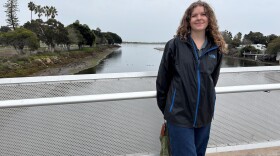The environmental group Heal the Bay published its annual report card with a mixed review for San Diego’s beaches. Heal the Bay assigns a letter grade to the water quality of 500 California beaches.
Thirteen of 17 coastal counties, including San Diego, had below-average grades for the wet season, with increased levels of bacteria and pollutants reported. Heal the Bay’s water quality scientist Luke Ginger says that’s due to heavy rainfall.
“In the winter it’s generally good water quality at San Diego beaches, meaning most of the beaches get A’s or B’s during the winter but only when it doesn’t rain,” Ginger said. “When it rains, we see a decrease in water quality. That's when beaches in San Diego County can get Cs, Ds, and Fs.”
But it’s not all bad news for beachgoers. In summer months when rainfall is low, San Diego beaches are mostly safe for swimming.
San Diego had 12 North County beaches listed on the “Honor Roll” with perfect water quality scores, including Carlsbad, Solana Beach, Cardiff and Encinitas. None of San Diego’s beaches made the “Beach Bummer” list, which ranks the state’s 10 most polluted beaches.
When it comes to the low grades at California beaches, climate change is one of the factors.

“Climate change will increase the amount of rainfall in coastal California as well as wildfires,” Ginger said. “Rainfall washes pollution into the water, and wildfires pretty much exacerbate that issue.”
That’s a concern to some tourists visiting San Diego, like Cory Sevill who is on a road trip to surf the California Coast.
“You start seeing a lot of changes in the weather patterns including more fires, the droughts, the floods,” Sevill said. “It does concern us. How does it affect the acid of the ocean? People come here to have fun, play, recreate and get exercise. How will that impact the waves and the surf?”
Another contributing factor is contamination flowing north from Mexico. Since April, more than 110 million gallons of sewage-tainted water has flowed into the Tijuana Estuary in the United States and out to the ocean.
“The City of Tijuana does not have sufficient sewage infrastructure for the amount of people who live there,” Ginger said. “Unfortunately a lot of sewage enters the Tijuana River, which then flows north across the river and empties out south of Imperial Beach in Border Field State Park.”
RELATED: Fixes Could Finally Be Coming For Mexico’s Cross-Border Sewage Spills
Contamination can have serious implications for swimmers, including ear, skin, and intestinal infections that are caused by bacteria, like total coliform, fecal coliform or e. coli, and enterococcus.

But Heal the Bay doesn’t want to be a bummer for beachgoers.
“It’s safe to swim at most beaches,” Ginger said, who recommends doing a survey of the beach when you arrive.
“See if there are any storm drains, look for little pools, little lagoons on the beach that can indicate the location of a storm drain.” Ginger said. He recommends staying at least 100 yards — think, the length of a football field — away from these higher risk areas.
Ginger says it’s not just up to swimmers. San Diego should learn from cities like Long Beach, that improved low grades through stormwater diversion and trash cleanup projects. “They should definitely start capturing more runoff. Divert it into the sewage system so it doesn’t just run untreated into the ocean,” Ginger said.
In addition to weekly grading of water quality at local beaches across the state, Heal the Bay has developed statistical models that can predict bacteria levels based on environmental variables like water temperature and wave patterns. They use this data to publish daily predictions for beaches in Oceanside, Encinitas, and La Jolla.
To find out whether your local beach is safe for swimming, click here.







